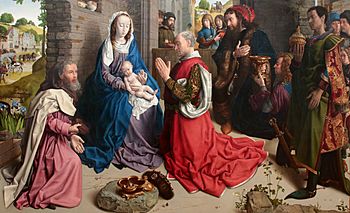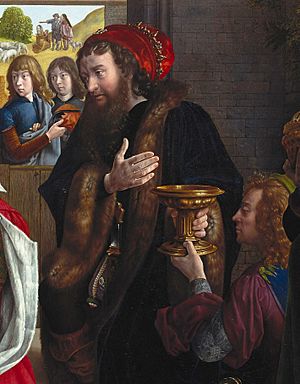Monforte Altarpiece facts for kids
Quick facts for kids Monforte Altarpiece |
|
|---|---|
 |
|
| Artist | Hugo van der Goes |
| Year | c. 1470 |
| Medium | Oil on wood |
| Dimensions | 147 cm × 242 cm (58 in × 95 in) |
| Location | Gemäldegalerie, Berlin |
The Monforte Altarpiece is a famous painting from around 1470. It was created by a Flemish artist named Hugo van der Goes. This artwork shows the story of the Adoration of the Magi, which is when the Three Wise Men visit baby Jesus. Today, you can see this painting in the Gemäldegalerie museum in Berlin, Germany.
This painting was originally the middle part of a larger artwork called a triptych. A triptych is a painting made of three panels, usually hinged together so the side panels can fold in. The side panels of the Monforte Altarpiece are now missing. We know they were there because of the hinges still on the frame. The top part of the main painting was also cut off at some point. In 2023, experts carefully recreated what the missing top section might have looked like for a special art show.
Contents
Discovering the Monforte Altarpiece
How did the painting get its name?
The painting gets its name from a place called Monforte de Lemos in northern Spain. It's believed the painting arrived there in the early 1500s. Before that, no one knows where it was. Art experts think it was painted around 1470. This was early in Hugo van der Goes's career as an artist.
Bringing the artwork to Berlin
In 1910, the painting was offered for sale in London, even though it was still in Spain. The Gemäldegalerie museum in Berlin wanted to buy it. Two art experts, Wilhelm von Bode and Max Jakob Friedländer, worked to get it. Friedländer even traveled to Spain to see it. Finally, in 1914, the Spanish government allowed the painting to be moved.
Who painted this masterpiece?
When the museum bought the painting, there was a debate about who the artist was. Friedländer believed it was by Hugo van der Goes because it looked similar to another famous work by him, the Portinari Altarpiece. However, another art historian, Heinrich Wölfflin, thought the painting looked too modern to be by van der Goes. He thought it was painted much later. Today, most experts agree that Hugo van der Goes did paint the Monforte Altarpiece. Its style was very advanced for its time!
Influence on other artists
The Monforte Altarpiece was so impressive that it inspired other artists. For example, the painting Adoration of the Kings by Jan Gossaert, painted around 1510-1515, uses some of the same figures and ideas from the Monforte Altarpiece.
What can you see in the painting?
The painting shows Mary with baby Jesus on her lap. The three Magi, or Wise Men, are kneeling before them.
The Three Wise Men
- The first Wise Man is kneeling right in front of Mary. He wears a bright red cloak. His crown, which has fur on it, is on the ground next to him. There's also a container filled with gold coins.
- Behind him is another Wise Man, who is also kneeling. He looks older and has his hand on his chest. He wears a crown over a red velvet hat. His clothes are fancy, and he has a small bag decorated with pearls and daisies.
- The third Wise Man is standing. He has dark skin and is already holding his gift. He is dressed very richly, even wearing spurs on his boots. Three servants are with him.
Other figures and details
In the background, you can see several shepherds. One of them, a bearded man with a fur hat, might even be the artist himself! Everyone in the painting is looking at baby Jesus. But Jesus, instead, looks out towards you, the viewer.
Like many paintings from the early Netherlandish art period, the ground in the front of the painting looks very wide, almost like a wide-angle lens photograph. The artist also added small symbolic details. You can spot an iris flower on the left side. There's also a tiny still life scene in a wall niche, showing a bowl, a pot, a wooden spoon, and a piece of bread.
On the left side of the painting, there's a landscape. You can see the Magi's procession, with buildings and a lake where horses and their grooms are resting. In the middle of the painting, another part of the landscape shows two shepherds pointing at something. There's also an older woman and a child. These two figures might represent Saint Elizabeth and the young St. John the Baptist visiting Jesus.
At the very top of the painting, you can see two pink and yellow pieces of cloth. These are what's left of angels that were once flying towards a comet. Those angels are now gone, but a similar idea appears in other artworks, like Jan Gossaert's Adoration of the Magi.
See also
- 100 Great Paintings, 1980 BBC series
- List of works by Hugo van der Goes


